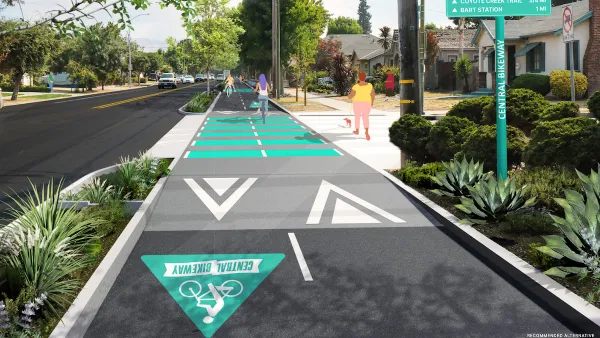Lawmakers want the federal government to set standards for vehicle height and visibility to combat the sharp rise in pedestrian deaths over the past decade.

The size of cars and trucks in the United States has ballooned over the past decade, and so have roadway fatalities, particularly pedestrian and cyclist deaths. Studies show there is a direct correlation. Lawmakers in Congress say enough is enough, reports NPR correspondent Joel Rose. Rep. Mary Gay Scanlong (D-Pa.) and co-sponsors introduced a bill last Friday called the Pedestrian Safety Act that “would require federal standards for hood heights and visibility to protect pedestrians and other vulnerable road users,” according to the NPR article.
The average U.S. passenger vehicle has gotten about 10 inches longer, 8 inches taller, and 1,000 pounds heavier, according to IIHS, and SUVs and pickups make up more than three-quarters of the vehicles on the road, up from 38 percent in 2009. And while studies show that larger vehicles tend to be safe with occupants, they are far deadlier for people outside the car. The NPR article cites an IIHS study that showed vehicles with higher front ends and blunt profiles are 45 percent more likely to cause fatalities in crashes with pedestrians than smaller cars and trucks.
“Safety advocates say that’s a big reason why annual pedestrian deaths in the U.S. are up more than 75% since reaching their lowest point in 2009,” Rose writes.
The bill would require the National Highway Traffic Safety Administration to set the standards, which would then apply to all new cars. According to the NPR article, it’s not the first time Congress has asked NHTSA to consider the safety of people outside of cars: “The Bipartisan Infrastructure Law directed the agency to expand its New Car Assessment Program to include pedestrians.” But safety advocates the resulting proposal for pedestrian crashworthiness testing had no teeth in that the program would be voluntary (meaning carmakers could opt out) and the pass-fail ratings would only be available through NHTSA’s website rather than on the five-star safety rating system that’s displayed on dealership car windows, where it has the most chance to inform consumers’ decisions.
Apart from pedestrian safety concerns, larger vehicles have additional implications for local, state, and federal governments. Bigger SUVs and trucks cause more wear and tear on roads, require more space to park, produce higher amounts of carbon emissions, and — as illustrated by this satirical cartoon — perpetuate America’s “car-is-king” approach to transportation.
FULL STORY: As cars and trucks get bigger and taller, lawmakers look to protect pedestrians

Planetizen Federal Action Tracker
A weekly monitor of how Trump’s orders and actions are impacting planners and planning in America.

Silicon Valley ‘Bike Superhighway’ Awarded $14M State Grant
A Caltrans grant brings the 10-mile Central Bikeway project connecting Santa Clara and East San Jose closer to fruition.

Amtrak Cutting Jobs, Funding to High-Speed Rail
The agency plans to cut 10 percent of its workforce and has confirmed it will not fund new high-speed rail projects.

California Set to Increase Electric Truck Chargers by 25%
The California Transportation Commission approved funding for an additional 500 charging ports for electric trucks along some of the state’s busiest freight corridors.

21 Climate Resilience Projects Cancelled by the EPA
The federal government has pulled funding for at least 21 projects related to farming, food systems, and environmental justice to comply with one of Trump’s early executive orders.

Trump Executive Order on Homelessness Calls for Forced Institutionalization
The order seeks to remove legal precedents and consent decrees that prevent cities from moving unhoused people from the street to treatment centers.
Urban Design for Planners 1: Software Tools
This six-course series explores essential urban design concepts using open source software and equips planners with the tools they need to participate fully in the urban design process.
Planning for Universal Design
Learn the tools for implementing Universal Design in planning regulations.
Yukon Government
Caltrans
New Jersey Institute of Technology
Mpact (founded as Rail~Volution)
City of Camden Redevelopment Agency
City of Norman, Oklahoma
City of Portland
City of Laramie





























